- John Crutchfield and Jennifer Gatti on the stage of Teatro Latea, where they performed Crutchfield’s Landscape with Missing Person.
*Photos by Jim R. Moore / Vaudevisuals.com
Only a few hours had passed since the Friday night wrap party for the latest Magnetic Theatre production on August 16. But director Steve Samuels and playwright/actor John Crutchfield were already analyzing their remount of Landscape with Missing Person just a little after 8 the next morning, over scrambled eggs, toast and an omelet at a neighborhood diner.
If you caught the world premiere of the work last August, the show reference is already there: One of the zanier scenes in Crutchfield’s script takes place in a sketchy roadhouse diner called Omelets R Us.
The comfortable patter between two longtime collaborators smoothes the rough edges of a morning after, as the sunlight filters over breakfast plates and cups of coffee. With a knowing smirk, Samuels calls his collaborator Don, after the middle-aged man Crutchfield plays in the production. Without missing a beat, the actor replies in turn, calling his director Rachel, the work’s other main protagonist and Don’s edgy, railroad punk traveling companion.
But in between the in-jokes and sore-arm tales of shows gone by, two keen minds are taking their production apart; assessing the strengths and probing the weaknesses of the show that just closed.
It’s just as clear this is hardly new territory to either artist.
With nearly a year to mull things over since Landscape’s initial run, Samuels had come up with a significantly different take on the lead male character before the start of rehearsals for this restaging. In most cases, this could be a hard sell when a show’s already set — and more than doubly so when the actor you’re trying to convince is also the work’s playwright.
But Samuels made his case, Crutchfield took the direction — and the central character, Don, became even more of an enigma the second time around. After actor and director carefully pared back the physical and psychological manifestations of the conflicts that propel Don on his odd cross-country odyssey in search of his ex-wife, audiences eerily matched Crutchfield’s stillness whenever he was on stage, as they closely scrutinized his minimal words and gestures for clues. The result was clearly a stronger production than its opening bow last fall.
It’s understandable if you missed it. It was a one-week run, for starters. And they didn’t stage the remount at the company’s former digs down at the Glen Rock Depot, or the Bebe, where they performed The Caro Savanti Experience to sold-out houses in July.
Three key things
Their venue instead was a place called Teatro Latea. You might not have heard of it since it’s a few miles north of town: about 690, all told, if you’re taking Interstate 81 and Interstate 78 to New York. That’s because Landscape with Missing Person was accepted for production at this year’s New York International Fringe Festival, a 17-year-old institution that has gradually become a mecca for independent theaters the world over.
It’s a fiercely competitive gig. This year, out of the 850 productions applying for the Fringe, as it’s called, 200 were accepted; by opening day, attrition had pared that number down to 185. Of that number, some 70 percent are productions from the tri-state region of New York, New Jersey and Connecticut — the locals. Ten percent are international. As a result, independent theater companies from everywhere else in the country vie for the few remaining slots.
Between Aug. 9 and 25, Fringe shows are scattered across 18 different theaters and an outdoor park across lower Manhattan. Everything from intimate solo shows to big-cast musicals appear in venues ranging from 40-seat black box studios to conventional 300-seat theaters.
The festival has become a major draw over the years. The prices are one reason: All seats, at all shows, go for $15 in advance, $18 at the door. If that’s a modest price for live theater anywhere else, it’s a steal in New York. Last year, the Fringe sold some 75,000 tickets, according to festival staff. And that’s not counting an estimated 15,000 industry comps: free tickets given to professional theater agents, producers, directors, publishers and the press.
Which explains another reason companies and artists really want to go to Fringe: over the years, it’s been a place where playwrights, actors and shows have been discovered. The acerbic musical Urinetown, which TheatreUNCA gave its regional premiere in 2009, got its start at the Fringe in 1999.
After a modest two-week stand, the work transferred to Broadway where it ran for more than two years, winning three Tony Awards in 2002. Mike Daisey, who achieved fame for a series of evening-length monologues before the notoriety associated with his 2010 work The Agony and Ecstacy of Steve Jobs, did his first New York solo show, 21 Dog Years, at the Fringe. Diminutive powerhouse actor, writer and producer Mindy Kaling (The Office, The Mindy Project) got her start playing Ben Affleck in her comedy, Matt & Ben, which was named in Time’s top 10 theatrical events for 2003.
The hub for all of this activity is called FringeCentral, a funky storefront toward the end of Second Avenue. Behind the blast of oversized, multicolored polka dots that fill the shop’s windows, dozens of different, colorful postcard-size playbills line the wall across from a ticket counter with a map of the region. Bulky set-piece benches and a piano in the midst are adjacent to a bulletin board routinely updated with the latest online and print reviews. With the constant influx of patrons, production personnel, staff and volunteers, the feel of the donated space falls somewhere between a bus terminal and a teen clubhouse slightly gone to seed.
Artistic director Eleana Holy rules the ceaseless bustle from the warren of offices in the back. It surprises first-timers to realize that she has detailed, firsthand knowledge of each of the shows in the festival. She has warm words for the plays of John Crutchfield.
She calls him “a returning alum” when we speak. Which is true: Crutchfield — and Magnetic Theatre’s — first bow at the Fringe was with his self-scripted solo show The Songs of Robert in 2009. The work won a judge’s award at the festival for outstanding solo performance, and Crutchfield garnered a publishing contract for the work. All in all, not bad for a playwright’s first outing in New York.
“We always look for three key things,” Holy notes: “innovation, vibrancy and diversity. [Landscape] hits all three points, I would say.” After calling Crutchfield’s new work “a lovely play about the human experience, and who’s actually the crazy one,” she says, “I’m a Southerner myself, and it’s nice to have Southern voices represented without being caricatures. With a New York-based festival, we get parodies and comedies with outlandish, extreme Southern characters, of course. It’s nice to have some good dark, human, and real Southern writing.”
As those who caught the show last year already know, Landscape more than obliges.
Four hours and a problem
Teatro Latea occupies the second floor of the Clemente Soto Vélez Cultural Center on the Lower East Side; a provisionally restored gothic building from 1897 that was originally the city’s P.S. 160. An intricate, wrought-iron flight of stairs leads to the theater itself. Its dimensions are broad but still pretty cozy; the matte black wooden floorboards in the audience area give, just a little, when you walk across them. Even with nods to the bare-bones tech — the lighting and sound boards are totally exposed, on the top level of risers in the center audience bank — the room has a warm, comfortable vibe.
In short, it’s nothing like it was when the Magnetic Theatre crew descended upon it the week before.
Industry insiders acknowledge that, with multiple productions being staged each day in the same venues, Fringe productions inevitably call for compromises. Part of that shows up in the gantlet each company endures when they first show up to the venue where they’re performing.
It’s a frenzied combination load-in, tech-in and full final dress rehearsal, during which the company proves they can fully load and set their production, with props, costumes and cast, in 15 minutes. They also have to demonstrate they can strike the show — completely — in the same amount of time.
In between those errands, the technicians must load a show’s worth of lighting and sound cues into the house boards. Then the group stages a full run-through.
Festival officials multiply the running time of your production by two. That’s the amount of time you have to complete these goals.
Magnetic Theatre had four hours — and a problem. When the technician originally slated to run the boards fell through, stage manager Rodney Smith had to find someone to replace her. He turned to his wife, Cyd, and his 13-year-old daughter Madison (who was assistant stage manager in the original production).
But armed with only his previous experience of manual lighting boards, Samuels was grasping at straws trying to build light cues, instrument by instrument, on the computerized lighting system. “I’m kind of a geek, so I would have gotten it,” Samuels admits, “but there simply wasn’t time.” As precious minutes passed, Alex Moore, Teatro Lateo’s technical director who had been looking in, made the save. “He was incredibly generous and kind,” Samuels notes. “This took so much help from so many people on the ground here.”
The company got a major break when they were allowed to store an unwieldy set piece — the bus-stop stand that transforms into counters, a bartop and a busted car at various points — backstage. “I lost sleep for nights trying to figure out how we could rent a moving van and store the thing between runs,” Samuels admits. “Not to mention hauling 150 pounds up and down that staircase before and after each show.”
The long way home
It’s the closing night of the run. The house, nearly full, has clearly remained engaged throughout the show. You can tell by the body language, sharp eyes and puzzled expressions that go sober when a plot twist is revealed that actors Crutchfield and Lisa M. Smith have kept the audience guessing all night long. The looks of concern tell you all you need to know: the New Yorkers in the seats, some of the most demanding theatergoers anywhere, have come to care about this mismatched pair.
Twice in Crutchfield’s endgame his character stands, bereft, gazing, from a short distance, at the beauty of a particular relationship he may never know himself. In those moments, Don’s a damaged angel, looking at a heaven so close, yet so elusive.
As an older woman in the audience sadly tilts her head against the shoulder of the man beside her, it occurs to me there’s a parallel here as well. From a similarly short, but uncrossable, distance, we look at him and Rachel. We care. But we cannot intervene.
It’s the second sort of heartbreak Crutchfield’s pensive script leaves us with. It’s the one we carry with us, the long way home.




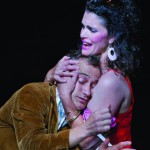
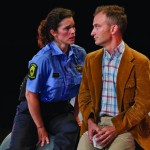
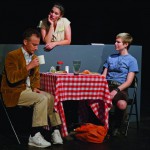
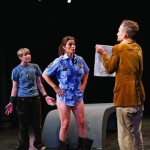
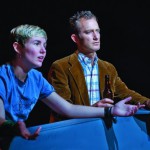
Before you comment
The comments section is here to provide a platform for civil dialogue on the issues we face together as a local community. Xpress is committed to offering this platform for all voices, but when the tone of the discussion gets nasty or strays off topic, we believe many people choose not to participate. Xpress editors are determined to moderate comments to ensure a constructive interchange is maintained. All comments judged not to be in keeping with the spirit of civil discourse will be removed and repeat violators will be banned. See here for our terms of service. Thank you for being part of this effort to promote respectful discussion.